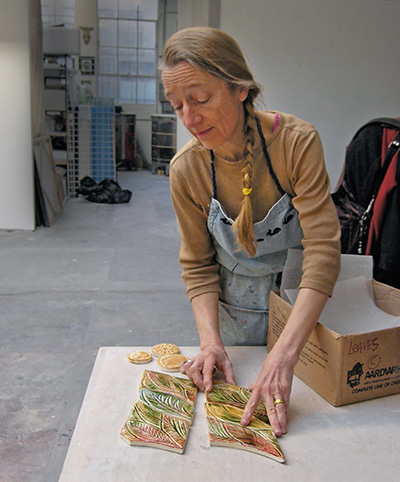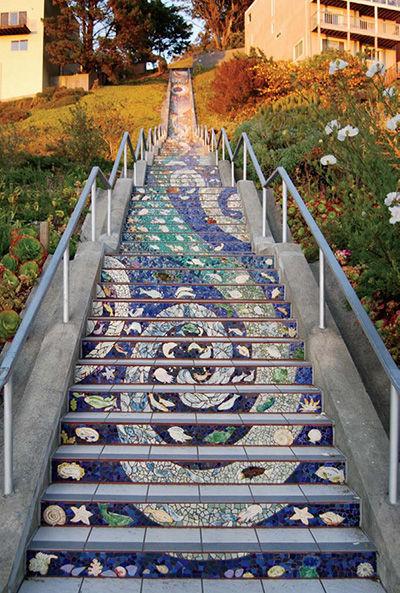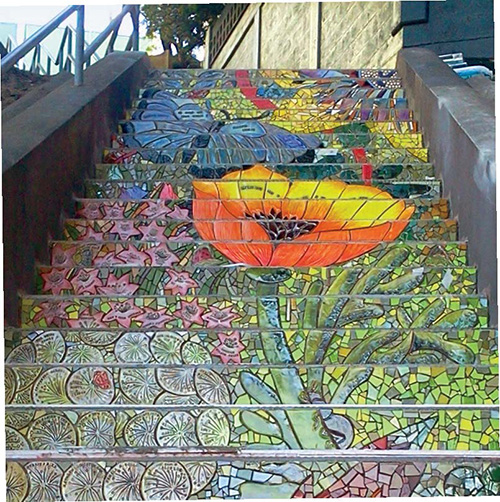For San Francisco artist Colette Crutcher, the climb to fame — of the kind that draws tourists in large buses to see her citywide mosaics and murals — was literally 163 steps high. It was the vivid tile-and-mosaic mural Crutcher helped create for a hillside staircase on Moraga Avenue at 16th Avenue that first garnered hits online and a top spot on several lists of the best things to see in the city.
Crutcher started creating sculptural mosaics from salvaged tile in 2002 during an arts residency at the Recology dump (formerly Norcal Waste Systems), and she continued using techniques learned there to make public art and murals, as well as decorative panels for fireplaces and backsplashes. “Tile was more durable than anything painted, and it made me want to do more,” she says.
The staircase project started in 2005 with the support of the San Francisco Arts Commission and a call for design proposals from Jessie Audette, a wind energy specialist who had recently returned to the U.S. from Brazil.
Audette had started using a vertiginous 1928 public staircase in her new neighborhood as her private Stairmaster, but soon began to think the utilitarian raw concrete 80-foot-high stairs could be tiled and decorated to echo the renowned Santa Teresa stairs she loved to climb while living in Rio de Janeiro.
“That beautiful staircase is bigger, higher and wider, has a massive quantity of tile, and was done over a period of about 12 years by one guy (Chilean artist Jorge Selaron) who was fairly crazy,” Crutcher says.

Well, it turns out Crutcher was almost as crazy. When Audette and neighborhood collaborators such as Alice Yee Xavier couldn’t choose between Crutcher’s mosaic design and the work of Irish tile-maker Aileen Barr and suggested the artists work as a team, Crutcher quickly agreed. The idea of having an accomplished partner for such a large endeavor, which eventually took a year to complete, “was definitely a good plan,” she says.
The design for the stair risers is a seamless combination of the two women’s individual visions. It includes Crutcher’s waterfall, flowing toward the ocean, and Barr’s seamless landscape incorporating the bay and the skies above, rendered with mosaics made of tile scraps as well as custom tiles made by both artists, who had never worked together before.
“Aileen taught me how to make tiles and I taught her how to do mosaics,” Crutcher recalls.

Like Crutcher’s other murals, the stairs’ design also began with a watercolor painting that served as a guide for the final work. The painting was sliced into 163 strips to form a template for each riser, which was then drawn to scale on paper and transferred to a plastic mesh backing fabric.
“We made alterations to the palette depending on what tile was donated by companies like Heath Ceramics,” Crutcher says. “Heath’s tile is gorgeous, high-fired and vitrified like glass. The blues and greens are amazing and the quality of their glazes affects the way the mosaic looks.”
In the end, the salvaged tile — cut by saws, broken with hammers and nipped into shapes before being glued to the mesh — was augmented by less than $300 worth of new commercial tile.

The rest of the $120,000 that Xavier and Audette raised, from about 300 individuals and a few businesses, paid for city permits, expensive raw materials, the artists’ textured handmade kiln-fired fish-, flower- and star-shaped clay tiles, and professional installers and grouters. Audette and Xavier convinced neighborhood volunteers to supply labor the pair could not afford — which had the bonus effect of making the staircase beautification a community effort.
“There really hadn’t been a precedent for something like this in the city,” Crutcher says. “The first people who donated their time and money were really taking a chance that it would happen at all.”
Since that award-winning staircase, Crutcher, her husband, artist Mark Roller, and Barr have done more public projects, including, through the city recreation and parks department, a lauded dragon-shaped play structure for a Mission District playground. But for Crutcher, the smaller private residential commissions she gets are equally appealing, because of the manageable scale and the speed at which she can now produce them. “Even in bathrooms, low-relief tiles like the ones I make now are interesting and fun,” she says.
Still, when people post pictures of cool things on websites and in guidebooks about the city, it is the 16th Avenue staircase that gets featured.
“We were up to our eyebrows in tile when Alice [Xavier] first commented that buses full of tourists would come to see our work, and we just laughed,” Crutcher says. However, Xavier was right. And the world still comes to stare.
This article originally appeared in Spaces Magazine.
More from Make It Better:
—Real Estate: 5 Bay Area Luxury Homes With Jaw-Dropping Views
—Been There, Done Hygge? Here Are 3 More Scandinavian Lifestyle Trends to Try

